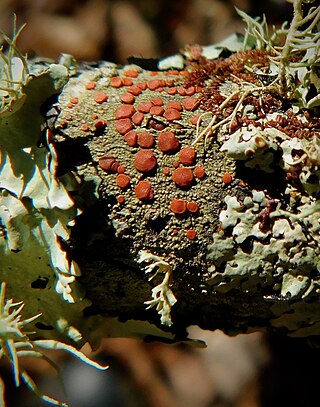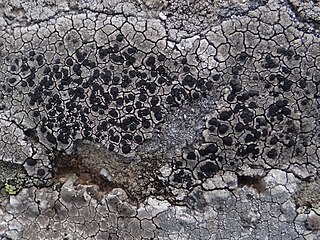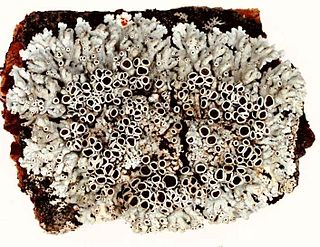
A lichen is a composite organism that arises from algae or cyanobacteria living among filaments of multiple fungi species in a mutualistic relationship. Lichens are important actors in nutrient cycling and act as producers which many higher trophic feeders feed on, such as reindeer, gastropods, nematodes, mites, and springtails. Lichens have properties different from those of their component organisms. They come in many colors, sizes, and forms and are sometimes plant-like, but are not plants. They may have tiny, leafless branches (fruticose); flat leaf-like structures (foliose); grow crust-like, adhering tightly to a surface (substrate) like a thick coat of paint (crustose); have a powder-like appearance (leprose); or other growth forms.

Rhizocarpon geographicum is a species of lichen, which grows on rocks in mountainous areas of low air pollution. Each lichen is a flat patch bordered by a black line of fungal hyphae. These patches grow adjacent to each other, leading to the appearance of a map or a patchwork field.

Muellerella is a genus of lichenicolous lichens in the family Verrucariaceae. The genus has a widespread distribution, especially in northern temperate areas, and contains species that live on other lichens, or on liverworts.

Lecidea atrobrunnea is a crustose lichen in the Lecideaceae family, found in mountains of the continental western United States and Alaska. With other lichen communities, it forms dark vertical drip-like stripings along drainage tracks in the rock faces, resulting in Native Americans giving the name "Face of a Young Woman Stained with Tears" to Half Dome. This combined lichen community appears black from a distance, but brown up close.

Crustose lichens are lichens that form a crust which strongly adheres to the substrate, making separation from the substrate impossible without destruction. The basic structure of crustose lichens consists of a cortex layer, an algal layer, and a medulla. The upper cortex layer is differentiated and is usually pigmented. The algal layer lies beneath the cortex. The medulla fastens the lichen to the substrate and is made up of fungal hyphae. The surface of crustose lichens is characterized by branching cracks that periodically close in response to climatic variations such as alternate wetting and drying regimes.

Lecanora muralis(Protoparmeliopsis muralis) is a waxy looking, pale yellowish green crustose lichen that usually grows in rosettes radiating from a center (placodioid) filled with disc-like yellowish-tan fruiting bodies (apothecia). It grows all over the world. It is extremely variable in its characteristics as a single taxon, and may represent a complex of species. The fruiting body parts have rims of tissue similar to that of the main nonfruiting body (thallus), which is called being lecanorine. It is paler and greener than L. mellea, and more yellow than L. sierrae. In California, it may be the most common member of the Lecanora genus found growing on rocks (saxicolous).

Lecanora polytropa, commonly known as the granite-speck rim lichen, is a species of saxicolous lichen in the family Parmeliaceae. A small, inconspicuous species that grows in the cracks of rock surfaces, it has a cosmopolitan distribution and has been recorded on all continents, including Antarctica.

Muellerella lichenicola is a species of lichenicolous fungus in the family Verrucariaceae. It was first formally described as a new species in 1826 by Søren Christian Sommerfelt, as Sphaeria lichenicola. David Leslie Hawksworth transferred it to the genus Muellerella in 1979.

Muellerella ventosicola is a species of lichenicolous fungus in the family Verrucariaceae. It shows preference to growing on species of the genus Rhizocarpon but can also associate with other genera.

Variospora aurantia is a species of lichen belonging to the family Teloschistaceae. In Sicily, it has been reported as a host for the lichenicolous fungus species Muellerella lichenicola.

Muellerella pygmaea is a species of lichenicolous fungus in the family Verrucariaceae. It has a cosmopolitan distribution in Arctic-alpine areas and grows on the thallus and apothecia of a number of hosts.
Zwackhiomyces polischukii is a species of lichenicolous (lichen-eating) fungus in the family Xanthopyreniaceae. It occurs in Ukraine, where it parasitises the crustose lichens Bacidia fraxinea and B. rubella.
Muellerella hospitans is a species of lichenicolous fungus in the family Verrucariaceae. It is known to infect the lichen Bacidia rubella.
Muellerella lecanactidis is a species of lichenicolous (lichen-dwelling) fungus in the family Verrucariaceae. It was formally described as a new species in 2003 by Paul Diederich and Pieter van den Boom, from specimens collected in California. The authors thought that the type specimen was parasitising a lichen from genus Lecanactis, hence the species epithet, but it was later discovered that the host was actually Sigridea californica.

Bacidia rubella is a species of corticolous (bark-dwelling), crustose lichen in the family Ramalinaceae.

Lecidea lapicida is a species of lichen in the family Lecideaceae. It has a worldwide distribution but it is rare in the tropics.

Physcia aipolia, commonly known as the Hoary rosette lichen, is a lichen species of fungus in the genus Physcia, and family Lecanoromycetes. Physcia aipolia is a species of lichen in the family Physciaceae. It has a worldwide distribution.Physcia aipolia is a known host species to the lichenicolous fungus species Muellerella lichenicola. It is characterized by the pale blue to gray thallus with many apothecia. Physcia aipolia is a common, widely distributed species, and can be found growing on a variety of trees and branches.
Carbonea assentiens is a species of lichen belonging to the family Lecanoraceae. It is found in Antarctica and in the islands of the subantarctic.
Capronia suijae is a species of lichenicolous fungus in the family Herpotrichiellaceae. Found in Belarus, it was formally described as a new species in 2017 by Andrei Tsurykau and Javier Etayo. The type specimen was collected from Ostrozhanka Village where it was found growing on the thallus of the bark-dwelling, crustose lichen Xanthoria parietina; Muellerella lichenicola was also simultaneously parasitizing the lichen. Capronia suijae is only known to occur at the type locality. The species epithet suijae honours Estonian lichenologist Ave Suija, "in recognition of her important contribution to the knowledge of lichenicolous fungi".












